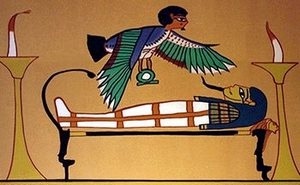The people looking for a cure or an insight to their problems were called Seekers. A Seeker had something on their mind, an ailment, an issue, and an inner quest to discover themselves. They came to seek an insight into their problems, to contact the healing god, to get a new vision that would heal, guide, or provide comfort. The path to the Temple was lined with huge the steles made of marble, on which were carved inscriptions, describing all the miracle cures, and the miraculous healing that had taken place in the Temple. It was claimed that people were cured of incurable diseases; the lame were able to walk again, people who were blind could see again. They were cured by the sole supernatural healing power of the divine dream.
This was a power that the priests knew from ancient times. The priests, who used secret rituals, incantations and traditions for therapeutic purposes, preserved this power; they were part priest, part physician, and part shaman. They were skilled in the interpretation of dreams; they were also skilled in the use of medicinal herbs. There were also attendants/caretakers of the temples, who had their own sacrifices and ritual activities to perform. They would council new seekers, also see to it that they were cleansed and purified. They were skilled practitioners and offered advice on how to seek interpretations of dreams.
The Seeker did not just go in to the temple; they had to wait for the right time to come. Before being allowed to enter the temple, and before the healing dreams could occur, they first had to learn the rituals and perform the rites of purification; they had to cleanse the body, mind and soul. They would meditate, fast, take hot baths, and make a sacrifice to the god. They looked for signs in their dreams. When the signs and omens looked right and they had cleansed the body, mind and soul, only then were they allowed to enter the main part of the temple. The main part of the temple had a large open floor area, with sacred alcoves to the sides, where the seekers could unroll their sacred skin, their Klínè; they would then sleep and dream of god Æsclepius healing them.
A good dream would be one in which the god would cure the wound by touching it. Once the person woke from their sleep, the attendant would spend time with them, reviewing any visitations from god, helping to explore the dream and secure the insights appropriate to that seeker at their stage of development. The dreams of the seeker contained the seeds of their own healing. The attendant’s job was simply to elicit the vision of the god and aid the seeker in making sense of their personal dream story. Through incubation, the seeker was to awaken to his real self and in so doing regenerate himself physically, mentally and spiritually. Today we recognize a lot of what went on in the Temples as suggestion therapy.
Over time the priests developed a greater understanding of herbs and their use. They started to move away from the sole use of dream interpretation and suggestion therapy, using their growing knowledge of herbs; they started to develop unguents, tinctures and medicines. Whilst dreams in their early forms involved a direct visit from the god, over time the dreams became more metaphoric, the dream became symbolic of the person’s problems. The attendants became dream interpreters, from these interpretations the priests would make up prescriptions for medicines. Over the past 4000 years, the Sleep Temple, the Priest and Dream Sleep, have slowly evolved in to what has become modern Doctors, hospitals and medicine.
The ancient Hebrews used meditation with chanting, breathing exercises and fixation on the Hebrew letters of the alphabet that spelled their name for God, to induce an ecstasy state called Kavanah. (These ritualistic practices are very similar to Auto-hypnosis). In the Talmud, Kavanah implies relaxation, concentration, correct attention (motivation). People such as fire-walkers, and priests who used the religious practices of laying on of hands to make people faint on to the floor, are using Auto-hypnosis to bring about an altered state of consciousness by the use of suggestion and expectation.
The Romans also adopted the use of healing sleep/Incubation Temples throughout their Empire. The Romans dedicated their Sleep Temples to the god Apollo – Æsclepius. Sleep Temples even got as far as Britain. Even now in the UK, you can visit a Roman archaeological site at Lydney Park, Lydney, Gloucestershire, where you can see the remains of a Sleep Temple. Sir Mortimer Wheeler excavated the Lydney Temple complex in 1928. One of Sir Mortimer’s assistants was the young Professor J.R.R.Tolkein, who went on to write “Lord of the Rings”; it has been suggested that he based Middle Earth on the landscape surrounding the Temple.
Post-Script: Maybe today’s Hypnotherapists consulting rooms can be viewed as the modern equivalent of the Sleep Temples, the couch a Klínè? But remember, “leave the healing god stuff, to a higher being.”


